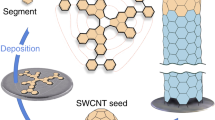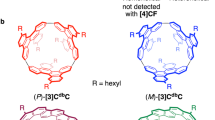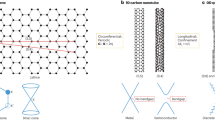Abstract
The chirality of single-walled carbon nanotubes affects many of their physical and electronic properties. Current production methods result in nanotubes of mixed chiralities, so facile extraction of specific chiralities of single-walled carbon nanotubes is an important step in their effective utilization. Here we show that the flavin mononucleotide, a common redox cofactor, wraps around single-walled carbon nanotubes in a helical pattern that imparts efficient individualization and chirality selection. The cooperative hydrogen bonding between adjacent flavin moieties results in the formation of a helical ribbon, which organizes around single-walled carbon nanotubes through concentric π–π interactions between the flavin mononucleotide and the underlying graphene wall. The strength of the helical flavin mononucleotide assembly is strongly dependent on nanotube chirality. In the presence of a surfactant, the flavin mononucleotide assembly is disrupted and replaced without precipitation by a surfactant micelle. The significantly higher affinity of the flavin mononucleotide assembly for (8,6)-single-walled carbon nanotubes results in an 85% chirality enrichment from a nanotube sample with broad diameter distribution.
This is a preview of subscription content, access via your institution
Access options
Subscribe to this journal
Receive 12 print issues and online access
$259.00 per year
only $21.58 per issue
Buy this article
- Purchase on Springer Link
- Instant access to full article PDF
Prices may be subject to local taxes which are calculated during checkout






Similar content being viewed by others
References
Dresselhaus, M. S., Dresselhaus, G. & Avouris, P. Carbon Nanotubes: Synthesis, Structure, Properties and Applications (Springer, Berlin, 2001).
Papadimitrakopoulos, F. & Ju, S.-Y., Purity rolled up in a tube. Nature 450, 486–487 (2007).
Zheng, M. et al. DNA-assisted dispersion and separation of carbon nanotubes. Nature Mater. 2, 338–342 (2003).
Zheng, M. et al. Structure-based carbon nanotube sorting by sequence-dependent DNA assembly. Science 302, 1545–1548 (2003).
Nish, A., Hwang, J.-Y., Doig, J. & Nicholas, R. J., Highly selective dispersion of single-walled carbon nanotubes using aromatic polymers. Nature Nanotech. 2, 640–646 (2007).
Chen, F., Wang, B., Chen, Y. & Li, L.-J., Toward the extraction of single species of single-walled carbon nanotubes using fluorene-based polymers. Nano Lett. 7, 3013–3017 (2007).
Peng, X. et al., Optically active single-walled carbon nanotubes. Nature Nanotech. 2, 361–365 (2007).
Chattopadhyay, D., Galeska, I. & Papadimitrakopoulos, F., A route for bulk separation of semiconducting from metallic single-wall carbon nanotubes. J. Am. Chem. Soc. 125, 3370–3375 (2003).
Kim, S. N., Luo, Z. & Papadimitrakopoulos, F., Diameter and metallicity dependent redox influences on the separation of single-wall carbon nanotubes. Nano Lett. 5, 2500–2504 (2005).
Krupke, R., Hennrich, F., Lohneysen, H. v. & Kappes, M. M., Separation of metallic from semiconducting single-walled carbon nanotubes. Science 301, 344–347 (2003).
Strano, M. S. et al., Electronic structure control of single-walled carbon nanotube functionalization. Science 301, 1519–1522 (2003).
Arnold, M. S., Green, A. A., Hulvat, J. F., Stupp, S. I. & Hersam, M. C., Sorting carbon nanotubes by electronic structure using density differentiation. Nature Nanotech. 1, 60–65 (2006).
Zheng, M. & Semke, E. D., Enrichment of single chirality carbon nanotubes. J. Am. Chem. Soc. 129, 6084–6085 (2007).
Massey, V., The chemical and biological versatility of riboflavin. Biochem. Soc. Trans. 28, 283–296 (2000).
Guiseppi-Elie, A., Lei, C. & Baughman, R. H., Direct electron transfer of glucose oxidase on carbon nanotubes. Nanotechnology 13, 559–564 (2002).
Patolsky, F., Weizmann, Y. & Willner, I., Long-range electrical contacting of redox enzymes by SWCNT connectors. Angew. Chem. Int. Ed. 43, 2113–2117 (2004).
Lin, C. S., Zhang, R. Q., Niehaus, T. A. & Frauenheim, T., Geometric and electronic structures of carbon nanotubes adsorbed with flavin adenine dinucleotide: A theoretical study. J. Phys. Chem. C 111, 4069–4073 (2007).
Ju, S. Y. & Papadimitrakopoulos, F., Synthesis and redox behavior of flavin mononucleotide-functionalized single-walled carbon nanotubes. J. Am. Chem. Soc. 130, 655–664 (2008).
Bachilo, S. M. et al., Structure-assigned optical spectra of single-walled carbon nanotubes. Science 298, 2361–2366 (2002).
Zheng, M. & Diner, B. A., Solution redox chemistry of carbon nanotubes. J. Am. Chem. Soc. 126, 15490–15494 (2004).
O'Connell, M. J., Eibergen, E. E. & Doorn, S. K., Chiral selectivity in the charge-transfer bleaching of single-walled carbon-nanotube spectra. Nature Nanotech. 4, 412–418 (2005).
Stryer, L. Biochemistry (W.H. Freeman & Company, New York, 1995).
Utsumi, S. et al., RBM band shift-evidenced dispersion mechanism of single-wall carbon nanotube bundles with NaDDBS. J. Colloid Interface Sci. 308, 276 (2007).
Tao, F. & Bernasek, S. L., Understanding odd-even effects in organic self-assembled monolayers. Chem. Rev. 107, 1408–1453 (2007).
Niyogi, S. et al., Selective aggregation of single-walled carbon nanotubes via salt addition. J. Am. Chem. Soc. 129, 1898–1899 (2007).
Chou, S. G. et al., Phonon-assisted excitonic recombination channels observed in DNA-wrapped carbon nanotubes using photoluminescence spectroscopy. Phys. Rev. Lett. 94, 127402 (2005).
Nikolaev, P. et al., Gas-phase catalytic growth of single-walled carbon nanotubes from carbon monooxide. Chem. Phys. Lett. 313, 91–97 (1999).
O'Connell, M. J. et al., Band gap fluorescence from individual single-walled carbon nanotubes. Science 297, 593–596 (2002).
Richard, C., Balavoine, F., Schultz, P., Ebbesen, T. W. & Mioskowski, C., Supramolecular self-assembly of lipid derivatives on carbon nanotubes. Science 300, 775–778 (2003).
Oyama, Y. et al., Photoluminescence intensity of single-wall carbon nanotubes. Carbon 44, 873–879 (2006).
Acknowledgements
The authors wish to thank Z. Luo, W. Kopcha and C. Badalucco for their help and S. Daniels for valuable discussions. This work has been supported mainly by Air Force Office of Scientific Research (AFOSR) FA9550-06-1-0030, and in part by National Science Foundation (NSF)-Nanoscale Interdisciplinary Research Team (NIRT) DMI-0422724, Army Research Office (ARO)-DAAD-19-02-1-10381, National Institute of Health (NIH)-ES013557 and the U.S. Army Medical Research W81XWH-05-1-0539.
Author information
Authors and Affiliations
Contributions
S.J. and F.P. conceived and designed the experiments. S.J. performed sample preparation along with PLE and UV-vis-NIR characterization. J.D. performed HRTEM analysis. S.J. and I.S. performed data analysis. S.J. and F.P. performed the molecular simulation. S.J. and F.P. co-wrote the paper.
Corresponding author
Supplementary information
Rights and permissions
About this article
Cite this article
Ju, SY., Doll, J., Sharma, I. et al. Selection of carbon nanotubes with specific chiralities using helical assemblies of flavin mononucleotide. Nature Nanotech 3, 356–362 (2008). https://doi.org/10.1038/nnano.2008.148
Received:
Accepted:
Published:
Issue Date:
DOI: https://doi.org/10.1038/nnano.2008.148
This article is cited by
-
Enhancing near-infrared photoluminescence from single-walled carbon nanotubes by defect-engineering using benzoyl peroxide
Scientific Reports (2020)
-
Quantitative analysis of the intertube coupling effect on the photoluminescence characteristics of distinct (n, m) carbon nanotubes dispersed in solution
Nano Research (2020)
-
Sorting Carbon Nanotubes
Topics in Current Chemistry (2017)
-
Selective silencing of the electrical properties of metallic single-walled carbon nanotubes by 4-nitrobenzenediazonium tetrafluoroborate
Journal of Materials Science (2014)
-
Short channel field-effect transistors from highly enriched semiconducting carbon nanotubes
Nano Research (2012)



